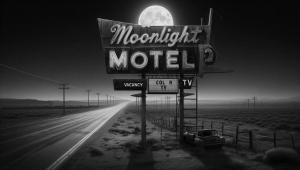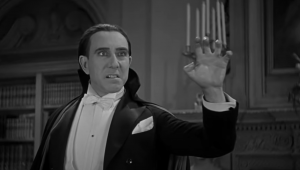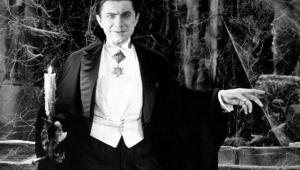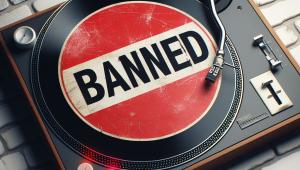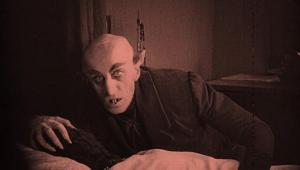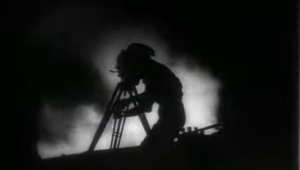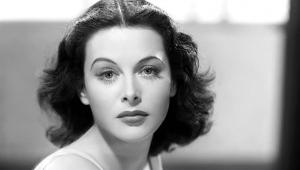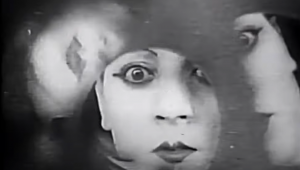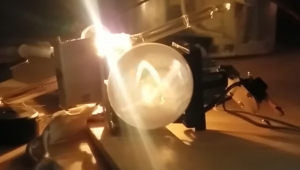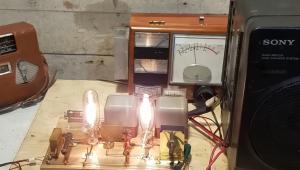There are other surround formats besides DVD-A. BD-A and SACD are doing just fine and are not that hard to find. Look at HRAudio.net and The Surround Discography and you will see new surround releases every year. The latest trend is releasing quad mixes from the 70's in discrete surround on SACD and/or BD-A. Unfortunately, too many people use the speakers in their HDTVs for sound; it's no wonder they prefer earbuds. Until that changes, listening to music through a home system that is not portable is going to stay a niche market.
Discrete-Channel Surround Music: The Dog That Won't Hunt

Leslie Shapiro's Grace Notes blog described how the Grammy people, those tabulators and keepers of recorded music, have officially bailed on the idea that surround music is viable. To put it succinctly: why bother giving an award to a category that (a) has virtually no entrants and (b) no one listens to anyway?
I would dearly love to hoist up passionate counterarguments to fly in the face of their arguments, but instead I'll simply say this: I agree. Stick a fork in it. Discrete-channel surround music is done and has been done for decades. In fact, it was never really a thing anyway.
As Leslie notes, DVD-Audio was our high-water mark. Audiophiles simply could not believe their good fortune. We finally had an amazing audio format that supported high bit rates (up to 9.6 Mbps!), and surround sound (up to 6 discrete channels!). Moreover, there wasn't even going to be a format war this time. DVD-Audio neatly piggybacked onto the wildly successful DVD-Video format. And it was a no-brainer to drop into car playback systems. We celebrated because the future for audio was bright.
Then, the morning after the celebration, DVD-Audio crashed and burned. This time it wasn't a chicken and egg problem. Plenty of DVD players supported both Video and Audio. And we already had surround receivers and speakers in place for movie playback. All we needed was some decent titles to listen to.
And there's the problem. There was never a killer title, never a title that sold millions of copies and showed just how wonderful music could be when recorded in surround. Instead, no one really knew what to do with those extra channels. The center channel was a good place to put lead vocals or otherwise shore up the front stereo imaging. And a subwoofer is always a good thing to have. But the raison d'etre for surround sound, the rear channels - how should those be employed in a music recording? Should the mix put the performers in front, and use the surrounds for hall ambience? So should you put dipoles in back? Or should the mix put you in the middle of the performers? So do you need direct-firing rears, and ones with performance equal to the fronts? Who knows!
The case for discrete-channel surround music was never really demonstrated, or at least never demonstrated so convincingly that a large number of listeners bought into it. Instead, surround sound was sold as a better way to enjoy movie playback, and surround music was an orphan that no one ever really wanted to adopt.
Let's toss in a few other trip wires: As I noted last time, convenience is a killer. No matter how good you are, if you are less convenient, you are in serious trouble. And playing surround music is less convenient that other types of listening. For starters, you have to sit in a particular chair in the middle of speakers, and refrain from moving for the duration. Just as the uber-mobile Earbud Generation was dawning, that was a serious buzz kill.
Along the same lines of inconvenience, DVD-Audio appeared just as downloads did too. Moreover, record stores started disappearing. It became a hassle to find and purchase DVD-Audio discs. Hitting a button to get a quick download (of a stereo recording) was far easier.
Another item: Yes, many of us had surround systems in place because we had home theaters. But the general public did not. The extra cost of buying new equipment, and the nontrivial problem of where to put it in the home, made surround (both movies and music) a nonstarter for many people. At best, surround music was destined to be a niche market for audiophiles, and that niche just never had enough fissile material to reach critical mass. It fizzled out.
And you know what? Although I listened to a lot of surround music, and immensely enjoyed it, I never really bought into it either. I enjoyed surround recordings a lot, and I enjoyed stereo recordings a lot. Discrete-channel surround music - in the final analysis, I could take it or leave it. When push came to shove, and it started to fade, I wasn't that upset.
And so here we are. Manufacturers and record labels have tried, and tried again (you might remember quadraphonic sound in the 70's) to jump start music-in-the-round, and failed each time. I'm sure it will be revived again in the future. But for now, that dog just won't hunt.
- Log in or register to post comments


The real killer for surround music, I think, is just that the overwhelming majority of people rarely if ever sit down and listen to a whole album. Even serious music listeners and professional musicians (and I have at times counted myself in both categories) rarely do this. I have a number of albums on DVD-Audio and SACD and would occasionally sit down to listen to a song in surround and say "oh that's neat", but I can count on my hands the number of times I listened to a whole album this way.
On top of that, it never really felt like more than a gimmick. "Oh that's neat". It doesn't really make the listening experience *better*. So how are you going to convince the general public to buy in? "Spend $500 on a player and $25 per album to replace a bunch of albums you already own in a new format that doesn't match the way you listen to music and adds nothing for you over a CD or good-quality digital download" is a complete non-starter.

Magic has its own, strange, rules. Stuff that's magic-ed up tends to de-materalize quickly. Take my 5.1 surround sound system. Got it two years ago. Being too big and too weird for the house, it has been sequestered to the garage, against its will. 5 Infinity Primus series speakers, Floor-stand front & rear, matching center, arrived at the local Amvets for $80, how could I resist? The Onkyo 7.1 A/V receiver? $50 at same, as well as a Samsung Blu-ray and Oppo DVD player, $30 each. Round off with three [count 'em] subs for around $50 each, what we got? $340? Throw in the copper linguini, we're lookin' at $400, tops.
Did it deliver? Yep, but for no more than two people at a time. And the weather these days is not amenable to hangin' out in the garage for extended periods of time.
More to the point, the Oppo went "poof", so I'm plum out of SACD players, unless I swipe my wife's, which I just might.
I'm listening to a lot more music these days, working at a desk job that encourages headphone use. There's some wonderful & wonderfully cheap headgear these days, good wired phones being cleared out for wireless. Combined with the crazy good Fiio X1 and Schiit Magni 3, I'm listening to more music than before, with better sound quality than before. The future of audio is physically smaller, for obvious reasons. The space that a surround system takes up has always been the [ahem] elephant in the room.

No, they haven't "bailed on" surround as "viable", they're just widening the category to allow in the newer 'immersive' formats.
Surround music is a niche category, like many other niche categories for Grammy nominees. Are 'Best Regional Roots Music Album' or 'Best Regional Mexican Music Album (including Tejano)' ever going to make the Billboard Hot 100?
But what's unique about the 'surround/immersive' formats is that all of the other formats are SPECIAL CASES of surround/immersive recording, so that 'surround/immersive' represents the technological peak of music recording/playback. It makes special demands on both composers/artists/engineers and on music listeners, but to some of us it's worth the trouble because the listening experience it provides is so much better than the lesser/restricted formats.
No less an audio authority than Floyd Toole has come down strongly on the necessity for multichannel music if high fidelity is the goal.
Ken, if spatial music is too much trouble for you, then don't bother. But for me and for all of the other lovers of surround/immersive music, there are enough of us to keep the format alive. Just over a year ago today, The Beatles released Sgt. Peppers Lonely Hearts Club Band in 5.1 on blu-ray, and there remains a thriving, if small, band of aficionados keeping the surround option alive today and for the foreseeable future.
I would like to see Sound & Vision promote and support the best available sound recording formats, not pander to the lowest common denominator.
The best is always the province of the few who take the trouble to appreciate it.

No one mentions how well Dolby Pro-Logic IIx Music Mode works on 2-channel recordings, and that may be a factor in why the discrete surround recordings haven't been faring well. A well-recorded CD can sound spectacular when played through DPL IIx Music, almost always putting the vocals and solo instruments in the center channels and providing realistic ambience in the rear when necessary, or instruments all the way around to provide that "in the studio" or "in the orchestra" effect. No flange-y, echo-y, artificial surround, but natural surround effects. I don't think DPL IIx Music gets the credit it deserves.
Oh, and if you listen to classical music, the masterful RCA 3-channel Living Stereo recordings from the '50s and '60s, and the Vox Box classical recordings from the '70s, which used the Sansui SQ matrix-quadrophonic system, sound incredible when played through DPL Ix Music Mode, as does just about any good recording. As for bad recordings...well, they suck no matter how many channels you have, from mono to Atmos!

I play QS and SQ quad LPs using Dolby Pro Logic IIx or DTS Neo:6 as a decoder. The decoding is not perfect, but it's still interesting, and it's easy to find quad LPs at a cheap price in very good condition. Both decoders have their own sound.

No one mentions DPL IIx Music Mode because the topic under discussion is explicitly "discrete-channel surround music", not multi-channel upconversion of 2-channel music recordings, which is completely different issue.

When I'm at a concert or show, the band is in front of me. I'm not sitting in the middle of the floor with the musicians all around me in 360 degrees, so what exactly is the point of surround music?
Yes, I have listened to surround music and it just felt... odd. Not better or worse, per se, just not 'normal'. I don't see a purpose to it.

...have a better appreciation for surround. It doesn't matter is you only played in a school band or orchestra, you know how real instruments are supposed to sound. Surround mixes are closer to that sound when done right. Many surround mixes are no better than many stereo mixes: all channels are really many mono channels that are synchronized. Just as binaural recordings are true stereo, in my opinion (check out Chesky Records), there is the equivalent for surround recordings. Check out AIX Records releases, also available on iTrax for download. Those have surround mixes from the audience's position and from a musician's position, and are not many channels of mono. The surround space is filled with music more closely to how a performance room is filled with music.

I've been a guitar player for 26 years and a piano player for 35 years. At no point have I or my fellow musicians that I play with ever stopped to consider "hmm, our music would sound better in a surround/immersive capacity".
The other thing to consider is that most surround music enthusiasts seem to focus on the surround itself and the aesthetic it provides, versus just appreciating the music. If a song is fantastic to begin with, it should take you to another place as is without unnecessary surround trickery. That's how I view it, anyway.

Yes, I agree--any time we were playing or recording, we were trying to get the performance on tape, and surround never came into the discussion. The reality is also that the majority of music studios are set up for 2-channel recording, not surround.

If your aim is to replicate at home the experience of a concert then the extra expense and effort required for surround music may not be for you. Surround music is my favorite way to listen, and it actually enhances concert recordings or classical music recordings because it replicates the ambience of the venue along with the music. For one thing, it puts you IN THE AUDIENCE with the crowd noises and ambience all around you, so it replicates the concert experience better than 2-channel. There is also music composed specifically for loudspeakers, and some of that music can be delivered in a live concert setting with loudspeakers around the audience. There really is such a thing as SPATIAL MUSIC which can only be realized with multichannel playback.

When you are at a concert or show, sound enters your ears from all directions, so listening to a concert recording with only 2 front channels is a serious compromise.
Also, when you are at a concert, it is possible that some of the musicians/sound sources may be placed around or within the audience, which can be a very interesting ear-opening, consciousness-raising experience. Music doesn't have to always emanate from the front sound stage.

Your argument is the same argument used in the 1950's and 60's for why stereo was not needed and mono was just fine (and also why binaural is the only true stereo, and few recordings were recorded binarually). I like mono, especially when I use a mono phono cartridge and one speaker so that the image is right, so I'm not knocking it. The benefit I find from stereo and surround is it's easier to hear the individual instruments, even if the channels are all really mono with no ambience between channels most of the time.
Since you are a musician, and you don't state what music you normally play, your thinking follows how concerts are presented these days, except for classical music: All instruments are mixed and dynamically compressed into one channel and the various speakers in the concert hall all have the same channel. I don't like it because it doesn't sound live to me. It sounds like a live recording, and I can play those at home for a lot less money. When I can get a seat near the stage, which is rare, and the speakers are behind me and I can hear the actual band without the mixing and compression, those have been the most enjoyable concerts. Soundboards used for mixing and compression have ruined the concert experience for me, so at least surround can sometimes give me back the experience.

In my view, The Beatles really made concert music obsolete, by making records that could not be performed on stage exactly as recorded. And I think that's a good thing. Getting rid of crowd noises and the other distractions and compromises that are part and parcel of live music concerts allows the music, and the communication between the artist/composer and the listener to be perfected. From this point of view, multichannel recording/playback is a natural and inevitable evolution of the relationship between the artist/composer and the listener.

Amazing that Sound and Vision is still beating on a dead horse (DVD-A), yet completely ignoring the victor of the format war from which DVD-A was vanquished, SACD.

Surround sound is and forever will be a niche. Just like "Gold Discs" and "SHM-CD" and other ideas that the public never will or could truly embrace, it is there for those that have the inclination to go the extra mile. Buy the extra equipment, spend the extra money for the premium content, create the space, deal with the lack of software, etc. The Quadraphonic era of the '70s failed because the technology was sub par upon release and only got good enough when the record companies and the public bailed. Too many early formats that really did little. The best quad was on eight track and reel to reel. One format the public battled with and the other it could not afford. In the late '90s when DVD-A was born it was derailed out of the gate by the copy protection being defeated (which kept DVD-A out of every DVD player made at launch), and Sony being Sony leaving the group and forcing multichannel onto its already released SACD product - creating a format war when one should have been avoided. The biggest issue was that by the time DVD-A and SACD began to feed the marketplace, the iPod came along and music was now in your pocket, a LOT of music was in your pocket. Headphones replaced the living room stereo, and today a Bluetooth Speaker IS the "stereo" in a huge percentage of homes. Walk into a home or apartment and you will probably not see a receiver, CD/BluRay player and speakers, a mainstay of homes for decades. This is a fact of the time. Just as the quad years, the labels pretty much stopped their output of surround product. Sony remarkably abandoned their mainstream SACD release program for the horrible "DualDisc", and WEA shifted from DVD-A to DualDisc as well, and then MVI and DVD-V for their enhanced releases, and the niche became a mouse hole. However, there have been remarkable releases since then from artists like The Beatles, Yes, Tom Petty, Pink Floyd, Fleetwood Mac, King Crimson, Steven Wilson, Coldplay, Love and Rockets, Pixies, Bob Marley, The Doors, Kraftwerk, Alan Parsons Project, Guns N' Roses and many more. Surround Music is a niche and requires product for people to support it and purchase it. The funny thing is the surround marketplace minority is very willing to spend money on physical product - something the download majority no longer feels is required. There is a message there somewhere.

Putting aside DVD Audio discs for a moment, it's worth noting that classical and jazz artists continue to release Surround Sound albums on Surround Sound SACDs to this day.
And over at NativeDSD Music, they just passed the 1,000 mark when it comes to Surround Sound DSD Downloads. With more being added almost every week. They even have a 15% Off sale (code: MULTI) this month (July 2018). Worth dropping by and picking up a few to expand your Surround Sound collection!
https://www.facebook.com/NativeDsdMusic/photos/a.765908406800903.1073741...

I have to say that I did enjoy surround, and still have a few dozen titles (along with a couple of "home brew" DVD-As sent to me by a quad collector who had done some really nice transfers), yet my surround equipment is now packed away. I don't feel it is worth the bother anymore, especially since the cost of my main speakers is too great and buying voice-matched surrounds would make it prohibitively expensive. I also don't have room for subwoofers. I don't watch movies (other than classics which are mostly monaural anyway), so I have no use for a home theater which could double for playing surround music.
The general public just never saw a use for surround. Nice gimmick to them, but nothing they would pay for. It costs a lot to have an album remixed in surround, so artists, their management and/or labels are not keen on spending so much for a niche product.



Here is the published statement by Jane Ira Bloom, winner for Best Surround Sound album at last year's Grammys. She is a musician's musician and cannot be dismissed as a crank or a minor player.
"Surround-sound was a natural step for me because I think I always thought that way as a musician to start with. I’ve always been interested in how sound changes when it moves. I move when I play the saxophone and visualize arcing sound in the air like a sculptor. Improvising with jazz musicians is a 3-D experience for me. Whether imagining music inspired by the zero gravity environment of space or the motion-filled brush strokes of Jackson Pollock, sound moves for me. So when my long-time engineer and co-producer Jim Anderson suggested that we record in surround, I was so on board with the idea. Our first surround project in 2013 was “Sixteen Sunsets” a spare all-ballads project for jazz quartet. “Early Americans” (2015) presented a very different kinetic energy with the spontaneous rhythmic drive of a sax, bass, drum jazz trio.
"Concepts that were on our mind when we went into the surround recording;
-How to capture the force of sound moving through a jazz trio
-How to capture the expansive range and deeply personal qualities of the individual players
-How to retain the warmth of the acoustic instruments while also giving reign to the rhythmic drive and power of the trio.
"We wanted all of that to come through the surround picture. The soprano saxophone is ideally suited to capture in surround too. If you think about it the sound of the instrument is less focused on projection from the bell and emanating from keys on all sides of the horn up and down the length of the instrument. It pretty much breathes in 360.
"From my point of view as a musician, I can tell you that surround-sound is a completely addictive listening experience. Once you hear it you never want to go back to stereo. It’s so immersive – like hearing your outsides in and your insides out. The ensemble and its sound are both surrounding your ears and also emanating from a body center. It’s “hyper real” and just so seductive - a spectacular sensory experience. I get chills just thinking about it. "—Jane Ira Bloom
